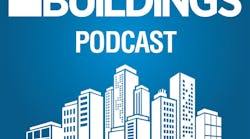Is your building connected? If not, Trevor Palmer from Acuity Brands talks with Janelle Penny about what happens when it is. He sheds light on the evolution of the smart building, growing from just energy savings and comfort to the occupant journey and experience in your facility. He shares three steps you can take to move forward.
Rather read their conversation?
[Start transcript]
Janelle Penny: Hi, I’m Janelle Penny, editor-in-chief of Buildings.com, and I’m here with Trevor Palmer. Trevor is the senior vice president of digital lighting networks for Acuity Brands, and he’s going to talk to us today about connected buildings and how to reimagine your building from a cost center to a strategic asset. Thanks for joining me, Trevor.
Trevor Palmer: No problem. It’s a pleasure to be here, Janelle. Thanks for the invitation. I appreciate it.
Janelle: So, what does it mean to reimagine your building?
Trevor: That’s a good question and one I get asked quite often. I love to talk about it. You do not want to get stuck next to me at a cocktail party, for sure.
It’s been a challenge. I’ve been in the buildings industry for about 25 years. And if you can imagine, when I started in building management system and temperature controls, we were really thinking about making comfort in the space. Likewise, in the lighting controls market, you’re talking about controlling lights for saving energy.
You know, the BMS (Building Management System) in lighting controls industries, really lighting industry in general has been going through kind of this transition from comfort and environment to how do I save energy and optimize space to learning about how these digital systems that we’re now putting in buildings can do so much more than just those things.
[Related: Connected Buildings Increase as Companies Prioritize Advantages]
And it really comes down to the 3-30-300 rule and potentially 3,000. So, when we talk about comfort and energy, we’re really focused on the $3 per square-foot on average that it costs and making that footprint of energy usage reduced. And we talk about the 30, that you start to get in comfort and environment and how these building owners differentiate the space.
But the real transformation that comes is when you start thinking about the 300, which is how much more productivity can you get out of the space per square-foot? On average it’s $300 per square-foot for employees, etc., and the overhead associated with them.
So, imagine if you could do more with these systems there in buildings to increase productivity, hopefully. And that’s really where the transformation starts.
Moreover, if we start to think about different use cases and different types of buildings, we’ve got a digital network in place to do lighting and building controls, but what about tracking assets within the facility? What about looking at where people are within the facility and helping guide them to other merchandise or other people? Or what other marketing insights can we provide?
For instance, retailers, with leveraging lighting or building controls as kind of an infrastructure to get more information.
So, getting people to understand that these systems we’re putting in today for lighting or building management, though they were focused on kind of the first three, the energy savings that they can get and maybe the comfort, they’re really poised to do so much more. And that can really convert the space from what was really traditionally just a cost center to an asset to make these companies more efficient or sell more merchandise or what have you, really become part of the customer’s journey. Does that make sense?
Janelle: Yes. Can you elaborate a little more about how to transition your building to a strategic asset?
Trevor: For instance, a retail environment is going to want to solve different problems and different challenges and have different opportunities than let’s say a school, right?
A simple example is making the facility managers and owners of the facility really connect and remember why they’re building the building, right? A building isn’t built to save energy. A building is built to host different activities.
So, a retailer wants to optimize that space to sell as much goods per square-foot as they possibly can. We start to think about what are the systemic things that we need to apply from a technology point of view in order to assist in doing that.
When we think about a school or even a college campus, the college campus is there to produce highly qualified graduates. And the more highly qualified graduates they train and put through that educational facility, the more funding they can attract.
So, how do we connect systems to help them solve some of those problems or exploit some of the great opportunities?
I love the college example. If you think about a lecture room, if the lights aren’t quite right, you have the wrong CO2 levels in the air, people are going to fall asleep, and they’re not going to be particularly attentive. You think about how systems—advanced systems—can solve those very, very basic problems. You can quickly realize that you’re doing more than just saving energy.
Janelle: Great. So, Trevor, can you talk about the evolution of a connected building and its value to facilities managers and building owners?
Trevor: Yeah. So, that’s a very good question. We’ve gone through quite an evolution over the past 25 or 30 years. It wasn’t so long ago when these systems were effectively focused almost completely on comfort, right?
I remember starting in the industry and running pneumatic tubes around a building to control temperature and it was almost completely driven by comfort.
We went through the next evolution, with the electronics evolution, the introduction of that technology into our marketplace. We quickly replaced pneumatic tubing with digital networks. They were not as quick and didn’t show the same bandwidth that we have today, but obviously they did a better job in connecting different rooms, different devices, to achieve not only comfort, but also energy savings as well.
I think the real transformation happened probably about 15 years ago, maybe a little less, with connected revolution.
So, connecting these systems to the internet—albeit, it was a bit of a renaissance period for the industry—but connecting these systems to the internet enabled them to be updated, get smarter over time, get new capabilities.
I think this next transformation is really not about comfort, not about energy, but it’s really getting these systems to do more than they’ve been traditionally designed to do in the past.
So, we’re using high-speed digital networks now. We’re still doing a fantastic job with energy savings, but really the focus is now on occupant experience and what the journey of that occupant is going to be through the space, how that space can be more efficient. But finally, what the outcome for the business is going to be. So, really focused on business performance itself.
So, that’s kind of the journey in short that we’ve gone through. And the technology has enabled us to make leaps and bounds through each step.
Janelle: What infrastructure are you looking at to connect and deliver this added value?
Trevor: Well, the great thing is you don’t have to have both of these infrastructures connected. It’s better if you do, obviously. A unified building strategy is always poised to save the most amount of energy, the most of operational efficiency in terms of helping facility managers manage their assets.
But really, lighting controls are very well poised. They’re at the right place, they’re everywhere, wherever we live, wherever we breathe within buildings and they’re constantly powered. So, they make an excellent host for any of these sensory technologies that you would need to control the space, but also do more.
But equally, building management systems, where we live and where we breathe, there’s heating ventilation and air conditioning equipment. And those also are generally speaking permanently powered and require control technology to provide comfort energy.
So, both of these together, and ultimately if they’re unified, provide the best benefit and the best host for these new technologies.
Janelle: Great. So, looking at the takeaways here, are there three things or three best practices you could recommend to audience members so they can get on the path to a connected building?
Trevor: Yeah. So, what I would say is the first thing you want to do is sit down—and this might sound silly—but you want to remember why you’re building the facility and who’s going to be occupying it. And what are the business—key performance indicators—that you’re looking to enhance?
That will drive to the second point, which is make sure whatever you’re putting in today or you’re designing in as a lighting control system or building management system, recognize that those are now OT (operational technology) systems, right? They can do much more than just manage energy or space comfort. They’re poised with high-speed networks to do so much more.
And the third thing I would say is, whatever manufacturer you’re working with or whatever consultant you’re working with, make sure that any system that you’re selecting, it might not have the capabilities to do all you want to do today, but understand it’s a connected infrastructure, right? And with these connected infrastructures, they can get smarter over time.
So, I guess focus on not only the building, but focus on the business. Think about the occupant’s journey and the occupant experience you want. And think through that you want these systems to be able to get smarter over a period of time. I would say those are kind of the top three areas.
Janelle: Great. Trevor, thank you again for joining me today.
Trevor: It’s a pleasure. I appreciate the invite and thank you very much for the opportunity.
Janelle: Great. This has been Janelle Penny, editor-in-chief of Buildings.com. And we’ll see you next time.
[End transcript]


